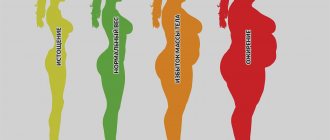Diet is a special regime and diet that determines the amount of food, its chemical composition and physical properties, as well as methods of culinary processing of food and meal intervals; nutrition that corresponds to gender, age, lifestyle, profession, state of health of a person and ensures the achievement of set goals.
The complex definition of a simple term makes it clear that a diet is a way of achieving a specific goal by changing the diet. The variety of goals determines the many types of diets. What principles underlie diet options? What types of diets are most effective? What types of diets are there?
The essence of medical diets
Many diseases worsen precisely because of poor nutrition. For example, if a patient with diabetes breaks his diet, his blood sugar level rapidly rises above normal, he is constantly thirsty, feels dry in his mouth, and fats accumulate in the cells of the liver and pancreas. Chronic pancreatitis makes itself felt with excessive consumption of fried, fatty foods (for example, pancakes, sour cream), as well as alcohol. If you have hypertension, you cannot eat a lot of salty foods, otherwise your blood pressure will rise above normal, and even treatment will not correct the situation.
It was already mentioned above that the types of diets in medicine (in hospitals, sanatoriums, dispensaries and other institutions of a similar type) differ in numbers. In addition to numbers from 1 to 15, there are also variations, such as N 1a, 16, N 7a, 7b, 7c, 7d.
Even if the patient’s exacerbation has passed, it is not recommended to go far from the principles of the type of dietary table prescribed to him. You still cannot eat prohibited foods, but you are allowed, for example, to eat something home-canned or use different processing methods. That is, simmer or, after boiling, bake.
And in order to get the daily requirement of vitamins, you can additionally drink rosehip decoction, eat wheat bran, or buy it at the pharmacy and take Hexavit, Decamevit, Gentavit, and other vitamin complexes.
No matter what type of diet we are talking about, alcohol is prohibited in any case. There are rare exceptions, but you still can’t do it without consulting your doctor.
If one patient is diagnosed with two diseases, each of which has its own diet, then a diet is prepared taking into account the requirements of each of the prescribed diets. For example, the type of diet for diabetes is table No. 1, but if the ulcer has worsened, then foods that are prohibited if it is present are removed from the menu.
Or here’s another example of the type of diet for diabetes - table No. 9. It provides six meals a day in the form of first and second breakfast, lunch, dinner, afternoon snack and a snack before bed. It is recommended to boil and bake food, but fried and stewed foods are sometimes allowed.
List of products allowed for consumption:
- Eat about 300 g of bread and other flour products per day. The bread should be rye, protein-bran, protein-wheat. If it is purely wheat, then it is made from second grade flour.
- Weak broths made from meat (low-fat varieties), fish, mushrooms with the addition of vegetables and cereals (only those that are not prohibited), potatoes, maybe with meatballs. Any vegetable first courses (borscht, okroshka, cabbage soup, etc.).
- Meat - lean, boiled (pork tenderloin, beef, veal, lamb, chicken, rabbit, turkey). In very small quantities - tongue, liver, dietary varieties of sausages.
- Fish - only low-fat. You can have canned fish, but only those in tomato or in its own juice.
- Milk, fermented milk products, low-fat cottage cheese, cheese (lightly salted, with low fat content). Sour cream - in very small quantities.
- Eggs - soft-boiled, no more than 1-1.5 eggs per day. An omelet is made from only whites.
- Legumes. Cereals - in the form of porridges (oatmeal, millet, buckwheat, barley, pearl barley).
- Vegetables (can be raw): pumpkin, cabbage, eggplant, zucchini, cucumbers, tomatoes, lettuce. In small quantities: potatoes, carrots, beets, green peas.
- Any sweet and sour fruits and berries - fresh or in the form of jellies, compotes and other dishes. Candies and cookies only contain sorbitol, xylitol or saccharin instead of sugar. Honey - just a little bit.
- Sauces - only low-fat ones, prepared in weak meat, fish, mushroom or vegetable broth. Pepper, mustard, horseradish - in very small quantities.
- Ghee and butter (unsalted) are allowed as fats. Vegetable - little by little, as part of dishes.
- Drinks include tea, coffee with milk, rosehip infusion, juices (any vegetable, and fruit and berry juices - only those that are not very sweet).

Contraindicated foods for this type of diet are rich or puff pastries, pastries, cakes, fatty fish or meat (pork, duck, goose) or broth made from them. You cannot eat smoked products (sausages or others), caviar, salty foods (fish, cheeses), curd cheeses, cream. Rice and semolina are excluded (including in the form of milk soup). Pasta is acceptable, but in very small quantities. Pickles and marinades, sweet fruits and dried fruits (dates, raisins, figs, bananas, grapes) are prohibited. Juices from sweet fruits, ice cream, candies, jam, alcohol, soda and cooking fats are prohibited.
The doctor decides how much sugar a patient can consume per day based on the prescribed dose of insulin.
Types of diets for weight loss
There are different types of weight loss diets. They differ from each other in the principles of creating a menu for the day. Here are the most popular weight loss diets:
- The so-called fast diets
are quite strict and can be designed for several days or for a whole month. Among them are kefir, banana, juice, for models and many others. Fast diets are used when you need to quickly lose 2-3 kg, but if we are talking about a large amount of excess weight, they are not suitable. Important: the fast diet menu must be composed competently and balanced. Otherwise, you will only get a metabolic failure, and the lost kilograms will very quickly return like a boomerang. - Mono-diets (fast option)
Their essence is that during the day, week or month the entire diet consists of one single product. It could be buckwheat, rice, apples, watermelon, etc. The menu turns out to be very limited, which cannot but have a negative impact on the functioning of the body. The following symptoms are often observed: dizziness, lethargy, decreased attention, apathetic state, very low blood pressure. Again, a very common occurrence with this type of diet is the rapid return of lost weight.As a more or less gentle version of a mono-diet, we can recommend fasting days (but not too often). Their essence is that on a certain day you adhere to a rather limited diet. This activates metabolism, promotes the removal of excess fluid, and reduces the load on the stomach and intestines.
- Low calorie diets
That is, there are no restrictions on the types of foods, but during the day you are allowed to consume a specific (rather small) amount of calories. Larisa Dolina lost weight on this diet; the Kremlin, Hollywood, Japanese, and egg diets are built on the same principle. The essence of the approach is that if you don’t give the body enough calories, it will begin to spend accumulated fat in search of energy for life. The following are important when using this type of diet:- The minimum permissible calorie content of the daily diet is 500 kcal;
take vitamins and minerals daily (in addition to those you get with food);
- To prevent muscle mass loss, exercise regularly.

The menu in low-calorie diets is quite varied, but side effects such as weakness, apathy, nervousness and anemia still occur. Sugar is completely excluded from the diet, so performance may also be reduced. It is better not to stay on such diets for a long time, but they are still ideal for those who need to lose a lot.
It is best to take an individual approach when calculating the rate of calorie intake (and, of course, fats, proteins and carbohydrates) per day. In addition, it is important to take into account how active a person’s lifestyle is, how his weight changes during the diet (and adjust the calorie intake accordingly), and include all the nutrients important for health in the menu. You should definitely do a so-called cheat meal (as athletes say), that is, days of respite from the diet.
- Low fat diets
This is a type of diet in which only low-fat or low-calorie foods are included in the diet. That is, only very fatty foods are prohibited. The effect of this kind of diet is very good and, importantly, the result lasts a long time.
- Low Carb Diets
Here, too, everything is clear - the menu is made up of low-carbohydrate products. It is carbohydrates, according to many nutritionists, that are deposited in the body in the form of excess fat if a person consumes more of them than he can spend in the process of life.
- High Protein Diets
With this type of diet, the menu mostly includes foods rich in animal protein (meat, fish).

Fruits and vegetables are also allowed to be consumed, but in small quantities. For those who have liver or kidney problems, such diets are not suitable. The result is a fairly strict diet with a small amount of vitamins and microelements. And the weight goes away due to the fact that a monotonous menu contributes to a decrease in appetite.
- Diets based on the selection of macronutrients
Perhaps these are the most effective diets of all existing ones. Their essence lies in the careful selection of products approved for consumption. Many popular protein diets, BEACH (protein-carbohydrate alternation), the systems of Pierre Dukan, Montignac and many others are built on this principle.
Here, acceptable and prohibited foods are summarized in a special table, plus recommendations for their preparation and even recipes for different dishes are added. For example, those losing weight according to Dukan can create a very tasty menu for themselves, because the list of allowed foods there is very diverse. This type of diet is especially good because they are very gentle, are not dangerous when used for a long time, and extra pounds disappear gradually and do not gain again.
As you can see, there are a lot of nutritional systems for weight loss, and anyone who wants to lose weight can choose the most suitable method for themselves. But remember that you should not do this without first consulting your doctor. The issue of a radical change in diet should be approached seriously and intelligently, taking into account the results of tests and the state of health in general. Only then will the diet be safe and effective.
Intermittent fasting
Last month I went deep into the current research on intermittent fasting (IF), and here's the short version. PG can be divided into 3 subgroups [45]: alternate-day fasting (ADF), 24-hour fasting (WDF) and daily time-restricted eating (TRF). The most studied variant of PG is alternate-day fasting, in which 24 hours of fasting alternate with 24 hours of eating (as the name suggests). It is not possible to achieve full compensation for missed meals during the day, and thus fasting every other day leads to the loss of both weight and fat [46,47], but there is also a loss of muscle mass [48].
Daily fasting involves one to two days of fasting every other week to achieve a calorie deficit. Although intermittent fasting is effective for weight loss, Harvey and colleagues observed no difference in body weight or percentage of body fat between the intermittent fasting group and a control group whose weekly calorie deficit was equivalent for more than 6 months [49]. ]. Daily food time restrictions include 16-20 hours of fasting and 4-8 hours of eating daily. The most well-studied form of daily food restriction is Ramadan - 1 month of complete fasting (refusing both food and water) from dawn to dusk. In this case, a significant weight loss is observed, but, as a rule, due to the loss of muscle mass along with fat mass [50,51]. A group of scientists led by Simon [52] recently conducted the largest systematic review of current research on intermittent fasting, comparing the effect of intermittent food restriction with the effect of long-term food restriction. They found that overall, both diets showed "about the same results" in terms of weight loss and body recomposition.
12 more popular diets in the world
Here is a list of twelve more diets that are very popular around the world.
- Cabbage, in which almost all dishes on the menu are made from cabbage. It contains a lot of vitamins, but, on the contrary, almost no fat. It takes a week.
- Hollywood, designed for two weeks. The main thing here is to eliminate fats, sugar and salt from your diet.
- Interval, in which you eat rice for three days, then potatoes for three days and vegetables for another three. Just nine days.
- Soup diet. The menu only includes soups, to which you cannot add potatoes and legumes. Duration - a week.
- Brazilian. This is when the diet consists of only fruits and vegetables. Sometimes soup is allowed. Duration - 7 days.
- Juice diet. The menu includes only freshly squeezed juices (orange, grapefruit and lemon). The dosage schedule is three times a day for three days.
- Another well-known diet is based on tomatoes. Lasts 7 days.
- Diet of eggs and honey. It is designed for three days, during each of which the dishes change.
- Diet with seafood in the diet. Not only does it show impressive results, but it is also very useful. Seafood is rich in healthy vitamins and acidic omega fats, which promote the rapid breakdown of subcutaneous fat. In addition, seafood is excellent in preventing many dangerous (even fatal) diseases.

- A diet designed for two weeks and allowing you to include only red and green foods in your diet (it’s called red-green).
- English. This is when the menu contains only dairy products and stewed vegetables. You choose the proportions yourself.
- Very effective - color. Lasts a week. The idea here is that you are only allowed to eat one specific color of food every day. The final day is clear, that is, you can only drink water.
To summarize, we can say the following: the choice of diet in each individual case should be approached very individually. Everything is important here: gender, age of a person, general health, how active he is in everyday life. In addition, you should always remember about possible contraindications, for example for pregnant women, or during lactation, or when a person is recovering from a serious and long-term illness. When you make your choice, the duration of the diet and the severity of the restrictions are not at the forefront. The main principle here is not to harm your own health.
Diet methods to effectively achieve your goal
By diet method we mean ways of following a particular diet. Thus, there are strict methods of dieting that do not involve replacing products or varying the diet. Other diets offer a variable menu, in which the main principle of the diet is compliance with the permissible calorie intake.
To select the most optimal diet principles, it is necessary to take into account a person’s lifestyle, the number of calories expended, gender, age, health status, possible contraindications (recovery from illness, pregnancy, lactation). Important factors in choosing an effective type of diet are the reasons for the appearance of excess weight, as well as the duration of the problem of excess weight.











